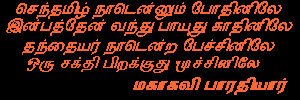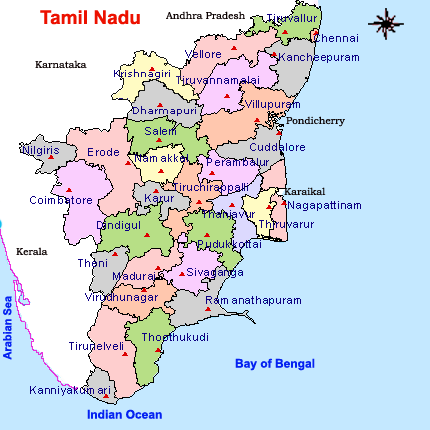|
|
|
|
|
|
|
Home*
Biography*
Social*
HAM Radio*
Islam*
India*
Tamil*
Genealogy*
Photo Gallery*
News* Articles* Achievers* Favorites* Links* Awards* Converters* Visitors* Site Map* Guest Book* EMail |


I love my mother-tongue Tamil and I am proud to be a Tamilian. At the same time we try to learn other Languages also. We should not hate other Languages. If we know more Languages we well get more knowledge. There is no differnece between Languages and no Language is superior to other Language. All Languages are equal and given by Almighty. Almighty Allah says in his Holy Qur-an " We sent not a messenger Except (to teach) in the language Of his (own) people, in order To make (things) clear to them" (Surathul Ibrahim - 14:4).







Tamil language spoken by tamilians, inhabitants of Tamil Nadu. Tamil is the mother tongue of more than 60 million people who live in the state of Tamil Nadu, which lies in the southeastern corner of the Indian subcontinent. It is also spoken by another 30 million Tamils who have emigrated to and have settled in countries like Singapore, Sri Lanka, Malaysia, Mauritius, Fuji, South Africa, Australia, UK, Canada, USA, etc.
Tamil is one of the oldest languages of the world. It belongs to the family of the Dravidian languages and is considered to be the source for other Dravidian languages. In addition to its antiquity, it is also rich in its literature. Some of the oldest Tamil literary works much predate the Christian era by at least three centuries. According to Prof. George Hart, University of California, Berkeley, a well-known Tamil Scholar, "The quality of Tamil literature is such that it is fit to stand beside the great literatures of Sanskrit, Greek, Latin, Persian and Arabic. The subtlety and profundity of its works, varied scope and universality qualify Tamil to stand as one of the great classical traditions of the world."
Tamil language has the special claim of being at once classical and vigorous like the modern Indian languages. Its history can be traced back to the age of
The earliest extant literature of the Tamils is called Sangam literature and it is dated between 500 BC. and 200 A.D. Though a considerable part of the early poetry has been lost, some of the bards and patrons decided to preserve apart of it in certain anthologies (about 4th century A.D.). These are the Ten Idylls
(Pattuppattu) and the Eight Anthologies (Ettuttohai). Four hundred and seventy three poets, of whom thirty are women, have been identified. These are mainly classified into two. Akam or esoteric dealing with love and Puram or exoteric dealing with war.In this period, Tamil literature was considerably bound by literary conventions. The poets were keen on keeping up the tradition. The land was treated as five regions viz. mountains, forests, fields, coasts and deserts and the theme of love in five aspects viz. union, patience, sulking, wailing and separation. The poet dealing with a certain aspect of love restricted himself to a particular region, season, hour, flora and fauna. These literary conventions are explained in
Tolkappiyam.Purananuru
is 400 verses on Puram themes. It serves as a window on the Tamil people 2000 years ago. Agananuru is 400 poems on love themes. The length of these poems varies from 13 to 37 lines. There are other collections like Natrinai, Kuruntogai, Ain-kurunuru, Paripadal, etc., which are quite well known.Thiruvalluvar's
Thirukkural is acclaimed to be the greatest Tamil classic. It expresses the most profound thoughts on the many problems of life. Each verse is a couplet composed with great economy of words. The book is divided into 133 chapters each containing 10 verses. The chapters are arranged in three books dealing with virtue, wealth and pleasure. It is one of the greatest and most succinct books ever written, by popular and critical opinion.Round about the 3rd century A.D., Tamil produced two epics
Silappadhikaram and Manimekhalai. The author of Silappadhikaram was the son of a Chera King Ilango Adikal. The title means the "Story of the Anklet" and the epic describes the moving story of Kannagi.Manimekhalai is the daughter of Madhavi and Kovalan, the hero of
Silappadhikaram. Kamba Ramayanam is an immortal classic in Tamil. Though Kambar based his work on the Sanskrit Ramayana of Valmiki, his rendering shows that he was a supreme artist. It is different in plot, in construction and in the delineation of character. Kambaramayanam runs to 10,368 verses.Tamil is rich in devotional literature Nayanmars are the exponents of Saivism and Alwars that of Vaishnavism. Thiru Gnanasambandar, Thirunanukkarasar, Sundarar and Manikkavacakar are the four great Nayanmars. The great Alwars are 12 in number. Kulasekhara Alwar and Andal are specially remembered. There are 5 major
kavyams and 5 minor kavyams in Tamil.Coming to the period between 13th & 18th centuries, The Muslim and Christian impact on Tamil literature. Umaruppulavar has composed a long poem of 5000 verses Seerapuraanam on the life of prophet Muhammed. The Christian influence began with the Portuguese and continued with the Danes, the Dutch, the French and the British. Beschi, Caldwell and Winslow have made significant contributions to Tamil. The Italian priest Beschi (1680-1747) composed the magnificent poetical work
Tembavani (The Insatiable Beauty) on the life of St.Joseph.Twentieth century has produced many talented men of letters in various fields, Poetry, Prose, Drama, Novel, Biography, Short Story etc. Dr. Swaminatha Iyer unearthed many literary works and edited them. Swami Vedachalam, Thiru V.Kalyanasundera Mudaliar and V. O.Chidambaram Pillai are great writers of the modern period. However, the greatest poet of modern Tamil is Subramania Bharati whose patriotic poems have inspired thousands of readers in his time. Personal freedom, national liberty and the fundamental equality of all men find eloquent expression in his verses.
Madhavayya, MRM Abdul Raheem, Kupa, Rajagopalan, Kaviko Abdul Rahman, Kalki Krishnamoorthy, Kavingar Vaira Muthu and Manavai Mustafa have contributed much to the field of Tamil fiction. These writers along with Bharati ushered in the new epoch of renaissance in Tamil literature.





| Go Back | Go Top | Go Next |